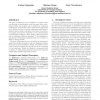Free Online Productivity Tools
i2Speak
i2Symbol
i2OCR
iTex2Img
iWeb2Print
iWeb2Shot
i2Type
iPdf2Split
iPdf2Merge
i2Bopomofo
i2Arabic
i2Style
i2Image
i2PDF
iLatex2Rtf
Sci2ools
DRM
2007
Springer
2007
Springer
Slicing obfuscations: design, correctness, and evaluation
The goal of obfuscation is to transform a program, without affecting its functionality, such that some secret information within the program can be hidden for as long as possible from an adversary armed with reverse engineering tools. Slicing is a form of reverse engineering which aims to abstract away a subset of program code based on a particular program point and is considered to be a potent program comprehension technique. Thus, slicing could be used as a way of attacking obfuscated programs. It is challenging to manufacture obfuscating transforms that are provably resilient to slicing attacks. We show in this paper how we can utilise the information gained from slicing a program to aid us in designing obfuscations that are more resistant to slicing. We extend a previously proposed technique and provide proofs of correctness for our transforms. Finally, we illustrate our approach with a number of obfuscating transforms and provide empirical results using software engineering metr...
| Added | 07 Jun 2010 |
| Updated | 07 Jun 2010 |
| Type | Conference |
| Year | 2007 |
| Where | DRM |
| Authors | Anirban Majumdar, Stephen Drape, Clark D. Thomborson |
Comments (0)

